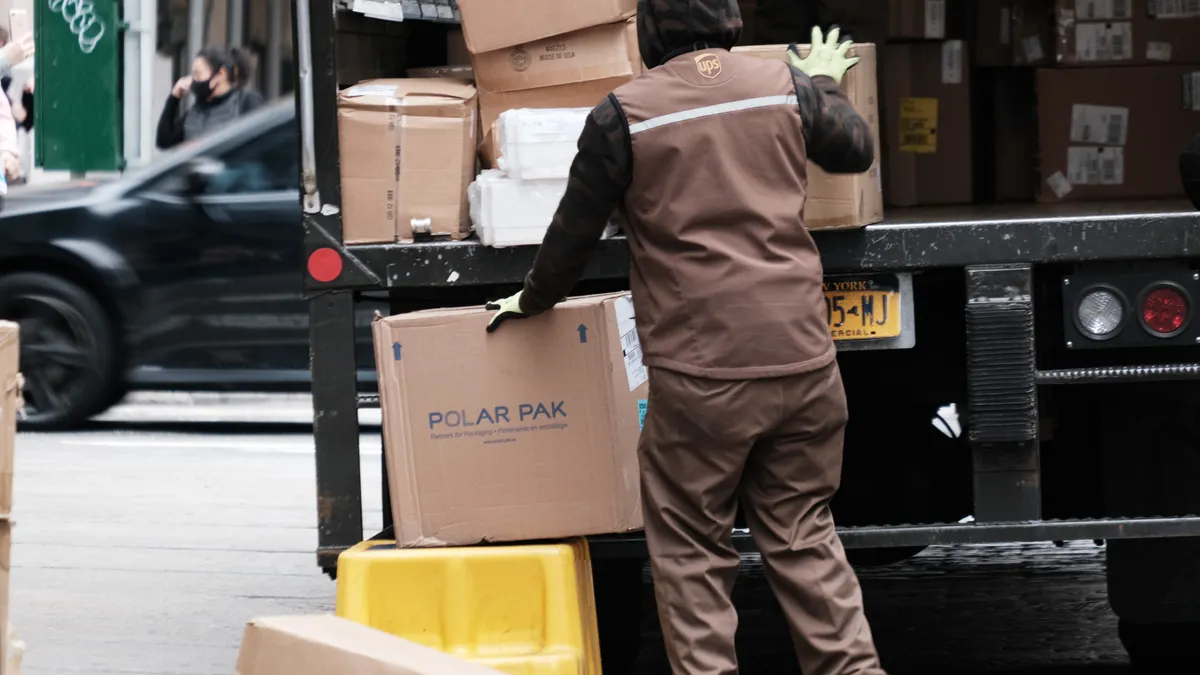Dive Brief:
- A shorter holiday shipping stretch and anticipated volume growth justifies UPS' heightened peak season surcharges, CEO Carol Tomé said during an earnings call last week.
- The later timing of Thanksgiving this year, falling on Nov. 28, will result in fewer days for orders between Black Friday and Christmas to be delivered than in previous years. That means the 2024 holiday shipping season will be the most condensed since 2019, Tomé said.
- UPS is expecting to encounter "the highest volume ever in our network" on Dec. 18, she added. "We think that the prices are going to stick because of what the environment is telling us from a demand perspective."
Dive Insight:
Even as shippers seek out lower-cost delivery options, UPS will implement surcharges for the 2024 peak season that are pricier compared to previous years. The amount of some surcharges varies by date, with prices peaking between Nov. 24 and Dec. 28.
Fee hikes will start Sept. 29 for bulky and hard-to-handle packages. On Oct. 27, demand surcharges will take effect for UPS Ground Residential, Air and SurePost packages. The added fees are slated to end on Jan. 18, 2025.
UPS 2024 peak season surcharges
| Surcharge name | Services affected | Peak surcharge range per package | Effective dates |
|---|---|---|---|
| Additional Handling | U.S. domestic, U.S. import and U.S. export shipments | $7.75 to $9.95 | Sept. 29 - Jan. 18, 2025 |
| Large Package Surcharge | U.S. domestic, U.S. import and U.S. export shipments | $84.75 to $99 | Sept. 29 - Jan. 18, 2025 |
| Over Maximum Limits | U.S. domestic, U.S. import and U.S. export shipments | $445 to $495 | Sept. 29 - Jan. 18, 2025 |
| Demand Surcharge | UPS Ground Residential, Air and SurePost packages | $0.25 to $2 | Oct. 27 - Jan. 18, 2025 |
| Demand Surcharge* | Certain UPS Ground Residential, Air Residential and SurePost packages for qualifying customers | $1.50 to $8.25 | Oct. 27 - Jan. 18, 2025 |
*Applies to customers who are billed for more than 20,000 packages during any week following October 2023, with the price based on how much their volume deviates from their "baseline" shipping activity.
The two demand surcharges are "a double whammy this year and will drive up costs" for customers that don't mitigate them, Onrout founder Jonathan Hessney said in a LinkedIn post.
"UPS has nicely given shippers more time than usual to prepare by releasing these in July (or it could be said they're moving first to try to get other carriers to follow)," he said. "Either way, there's still time to try to onboard alternatives, or negotiate discounts on the peak surcharges."
On UPS’ earnings call, Wolfe Research Managing Director and Senior Analyst Scott Group told executives that the size and magnitude of the surcharges came as a surprise. But the amount of volume UPS anticipates it will handle during peak justifies the pricing, according to Tomé.
UPS is grappling with a surge in volume from new e-commerce customers leveraging its SurePost service, CFO Brian Dykes said. The company's network capacity will soon be tested further by the emergence of its new contract with the U.S. Postal Service. The company expects to fully onboard the Postal Service as an air cargo customer before the holidays.
"When you have that kind of volume flowing to your network, you actually have to charge to service them well, because you have to hire people and lease aircraft and delivery vehicles, so on and so forth," Tomé said.
UPS rival FedEx is also confident in its ability to capture added revenue from peak season surcharges, EVP and Chief Customer Officer Brie Carere said during a June earnings call. As of Friday morning, FedEx has not released its 2024 peak season surcharges.
"The team has done a really good job in getting the increase we need to deliver an amazing peak where we do have to expand capacity," Carere said.












